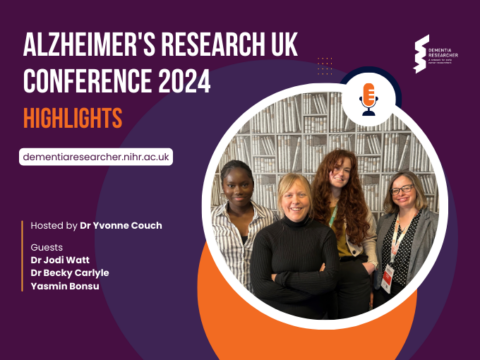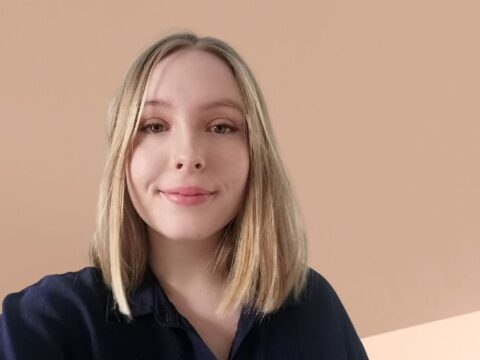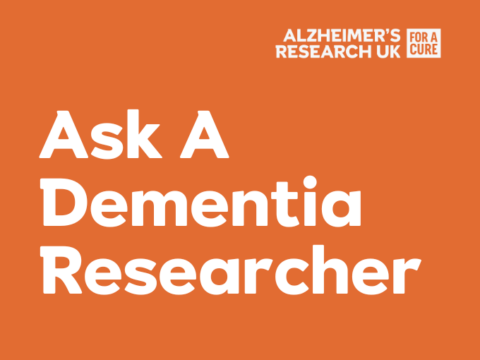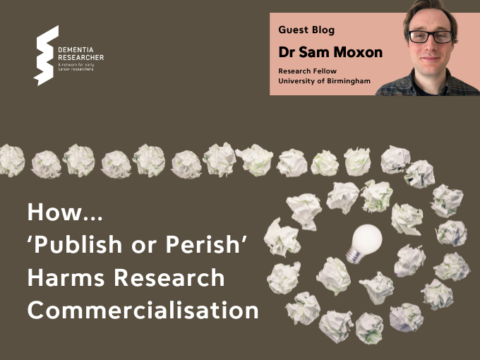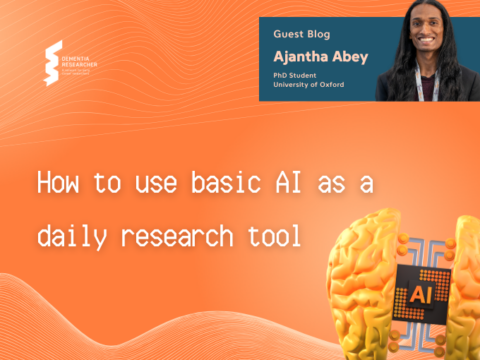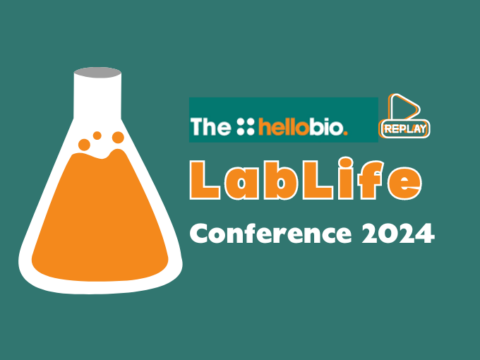Open science, open access, publication timelines are all discussed in our podcast this week with PLOS ONE Associate Editor George Vousden and Research Manager Rui Maruricio at ARUK.
PLOS ONE has launched a call-for-papers, inviting researchers to submit their latest research on the early diagnosis and treatment of Alzheimer’s disease. The impact of AD may be lessened by timely diagnosis, allowing access to care pathways and enabling planning for advanced care. Likewise, the ability to diagnose AD at its early stages is likely a prerequisite for the successful implementation of novel disease-modifying treatments. Submissions are welcome across all disciplines, including basic research, translational studies in animal models and studies in patient populations.
https://collections.plos.org/s/alzheimersdisease
Voice Over:
Welcome to the Dementia Researcher podcast, brought to you by dementiaresearcher.nihr.ac.uk, a network for early career researchers.
Megan Calvert-O’Hare:
Hello everyone. My name is Megan O’Hare and I’m a research associate working for the NIHR at UCL. Today we’re going to talk about publishing and we’ve got a quick plug from Plus One today. So as the aging population continues to grow, the prevalence of Alzheimer’s disease is expected to rise. The disease incurs enormous economic and social costs and represents a major public health burden. The high social impact of Alzheimer’s disease is partly due to the fact that no known cure exists, which I think we’re all very well aware of. With existing treatments being largely palliative, the impact of Alzheimer’s disease may be lessened by timely diagnosis, allowing access to care pathways and enabling planning for advanced care. Whilst early diagnosis of the disease remains challenging, a number of research approaches have shown promise in addressing this critical need.
Megan Calvert-O’Hare:
Current diagnostics of Alzheimer’s disease include clinical evaluation and psychological tests. In addition, research has shown the value of examining biological markers, such as structural changes within the brain, measured by MRI, detecting amyloid and TAU, with PET scans and measuring a variety of proteins including amyloid in blood plasma. Further work in this area is required to establish reliable diagnostics that can be easily implemented into routine clinical practice. The ability to diagnose Alzheimer’s disease early stages, is likely a prerequisite for the successful implementation of novel disease modifying treatments. To date, no such therapies exist, whilst reversing the damage caused by the disease will likely prove difficult, there is hope that novel treatments will be able to prevent or retard the progression of symptoms and deterioration in quality of life that is characteristic of the disease.
Megan Calvert-O’Hare:
Researchers are required at all stages of the pipeline to identify potential drug targets and novel treatments for the disease. Bringing earlier diagnoses and effective treatments to patients will require collaboration of researchers across multiple fields. The broad scope of Plus One facilitates publication of the interdisciplinary research necessary to address the high social impact of this disease. And this is where I’d like to introduce George Vousden, the associate editor of Plus, who will talk a little bit about the actual call that him and Alzheimer’s Research UK are putting together. Which is one of the main reasons we’ve got together today, but we will also talk more generally about publishing, but if you could just tell us a little bit about the call quickly.
George Vousden:
Yeah. So I mean obviously we just heard the scope of the call for papers, so I think that probably summaries the sort of research that we’re really hoping to attract and also the importance of why we need research in this area. So if you submit your paper to the call for papers, the plan will be that those papers have the opportunity to be included in the collection. So what a collection is, is it’s essentially a group of papers on a particular topic, so in this case, this is going to be entitled the early diagnosis and treatment of Alzheimer’s disease. And the plan is to bring all those different stages of the research pipeline together, so you can have early in silico or in vitro analysis of potential drug targets, all the way through to clinical trials in one location all on the Plus website.
George Vousden:
So the collection is curated by four guests editors. So we have four guests, editors, that are experts within the field, along different stages of those pipelines. So for example, one of our guests editors is Michael Viner. So he is the principal investigator on the Alzheimer’s disease neuroimaging initiative and this is a very large cohort study in the United States of America, that includes multiple institutions and it’s going across the whole country. And this includes individuals, healthy individuals, individuals with mild cognitive impairment and individuals with Alzheimer’s disease. And it’s recording various neuroimaging and blood markers that could be potentially used to diagnose Alzheimer’s disease.
George Vousden:
As I said, so we have guest services across the different spectrum. So you also have someone called Yona Levites, who works on preclinical work looking at novel immuno therapeutic treatments for Alzheimer’s disease in animal models. Also have Roberta Brinton, who is another guest editor and she works on both preclinical and clinical work. And some of her work includes looking at the reasons why Alzheimer’s disease is more prevalent in females than males. And then our final guest editor who will be deciding which papers go in this collection, is UC Tocka, who works on machine learning and looking at how we can use machine learning approaches to try and improve the diagnosis of Alzheimer’s disease.
Megan Calvert-O’Hare:
Thank you. That sounds really good. AR UK is working to promote this call to papers. Rui, I wondered why do you think this is so important?
Rui Mauricio:
It’s really interesting that we’re getting into this new age of earlier diagnosis because as we know, a lot of the clinical trials into Alzheimer’s disease in the past have failed and it’s probably because we’re intervening too late in the disease process. So this is one of the things that research has shown us, is that by the time we’re intervening in clinical trials, the damage to the brain has been to extensive and so there’s nothing that can be done because it can’t be regenerated, which means that we’re trying to then find people with the disease earlier, before all this damage has occurred to the brain so we can intervene and stop the progression of the disease. And so it’s really interesting that Plus One is now creating this because it can stimulate research into this area, which is what we need. We need to understand more, we need to investigate more to understand when is the best time to intervene and what is the best intervention in the clinical trials.
Megan Calvert-O’Hare:
Okay. So maybe moving away from this actual call for papers, we could talk a little bit about open science and what is open science and why it’s important. Maybe George you could …
George Vousden:
Yeah, so I mean open science is a very broad topic and really could include anything from different stages within the research process. So I’ll just talk about a few examples. One thing you could do is you could pre-register your study. So what this means is that before you start data collection, you might say, “Right, I’m going to do this study and I’m going to have outcomes of A and B.” And the idea is, is that you make that openly available so that everyone is aware before you start your study, what it is exactly you’re going to be looking at. So then you can perform your study and then the idea would be that you report on outcomes A and B.
George Vousden:
What that stops is people looking post-hoc and seeing that actually outcome C was really interesting and ignoring … So let’s say that outcome A and B, you don’t get the response you’re expecting, but in outcome C, you do. It’d be very easy to rephrase your whole submission to say, “We were always really interested in outcome C.” So this is an idea that’s been around in clinical trials for some time and any clinical trials that are carried out should always be registered. But we’re also seeing that this is coming in, this is gaining speed in nonclinical trials and preclinical research. So I guess that’s one thing.
Megan Calvert-O’Hare:
Sorry. So you said with clinical trials that’s been around for a while. Is that also because we talk a lot about patient and public involvement and being involved in actually setting up the clinical trials, so would that be a point where you’re saying, “I’m doing this trial, we’re looking for outcomes A and B.” And you’d get PPI involved and they would say, “Well that’s not relevant to us.” And if that’s true, would that translate into nonclinical research as well? PPI, patient and public involvement. So maybe Rui, you know a bit more about this.
Rui Mauricio:
Yeah, so this would be, from what George is saying, it would be the perfect opportunity to involve people and understand are these the outcomes that you are looking for? Are these the preferred outcomes? Because one of the problems with research in the past, is that, and I was a researcher so I’m guilty of this as well, is we’re trying to figure out what people would want in their lives. What sort of treatment, what sort of outcomes would they prefer, when actually the easiest thing is to just go to people and ask them, “Is this the outcome that you prefer?” So then we can work together towards something, rather than researchers working independently from people and maybe coming up with something that is not fit for purpose. So this would be the perfect opportunity to go, “These are the outcomes for the current clinical trials. Do you agree? Do you have any suggestions? Would yeah prefer something else?” And then it would save time and resources, adjusting that expectation in the work.
Megan Calvert-O’Hare:
And how does a journal fit into any open science like that? Because the cynic in me says, publishing, you want to publish and sell publications. So you want the best research and you don’t necessarily mind if it means that they’ve not followed the protocol of saying we wanted A and B, if C actually was the headline grabbing result. So how would a journal fit into that?
George Vousden:
Well, I think that the best research is reproducible research. And I think that pre-declaring your outcomes as to what’s expected and being completely open and honest as to what you expected to happen and why you did that, it means that everything is a lot more reproducible. So I mean you might be familiar with the idea of P was 0.05, so this is the idea that if it’s less than 0.05, then it’s significant, which is debatable, but I guess that’s a different topic. But what that means in actuality is that one in 20 results will occur by chance, if you accept that P equals 0.05.
George Vousden:
So if you had a study that had 20 outcomes, one of those would cause a significant result purely by chance. So that would be the case, even if you had completely random data. Obviously as a journal, we don’t want to be publishing results that aren’t reproducible in that case, because that result would have occurred purely by chance. And I think as a journal we all want our work to have impact and we want it to affect and progress the field and making sure that the work is reproducible really ensures that
Rui Mauricio:
I want to jump in there from something that George said. He talked about being open and transparent and I think that’s one of the key things of open science, even though it’s such a broad term, the main elements of open science is being able to be open and transparent, sharing and working together. When I think about open science, I always think back to my times in school, the first years of school when we had group projects, and this is before competition and politics and mind games all started in school, but the very first years, the innocent, four, five, six the innocent years of school, when everyone is in a classroom working together on projects, everyone in different groups, but everyone is working together.
Rui Mauricio:
I remember making wooden boxes or paintings or something and I would work with my group and then go to other groups and ask, “Have you managed to finish the box? How did you overcome this particular step? How did you do that?” I was very eloquent when I was four. “How did you do this? How did you finish your painting? Do you have materials because we’ve ran out of this?” And everyone in the classroom was working together because they knew as soon as we finished this we get to go outside and play. So if we work together, we finish earlier and that’s for me is the idea of open science, is people around the world working on their wooden boxes and sharing everything that they’re doing, working together, and that is the way that we can progress and advance science faster.
Megan Calvert-O’Hare:
Yeah. I think something you said earlier about being open, and you were saying you used to be a researcher, me too. It can feel like you’re quite closed doors when you’re doing your own project because there is the pressure to publish, I’m not blaming George in any way, but that pressure to publish with your name on. So it doesn’t matter how many people helped you paint your wooden box, at the end of the day you want your name on it in George’s journal to get your next grant because that’s how it’s set up. And it would be better if we could all paint together.
Rui Mauricio:
Yeah. This is one of the barriers to open science, is the fact that especially in biological sciences, your career progression depends on high impact publications. It depends on finding those breakthroughs, those amazing results that then give you that publication and allow you to progress your career. But if we start looking at other ways of recognising scientific contribution, being sharing datasets, sharing negative results. So for example, I did a PhD, for three years of my PhD, I had negative results. I had a couple of months of positive things that allowed me to publish, but those three years is work that is useful to other people. It’s useful to know this didn’t work because of this. And this is one of the things that we can value in research, to go around those high impact publications necessary for career progression.
Megan Calvert-O’Hare:
Yeah, sharing negative results comes up a lot. I know that some journals do, once you publish, you then also give them basically your whole data set. Do Plus One operate a similar thing, so that then the data is in the public space and you can almost go in and have a look?
George Vousden:
Yes, exactly. So Plus is completely supportive of open data sharing and as of 2014, every paper that Plus publishers, so not just Plus One, but all of the other journals that Plus publishes, all have to include a data availability statement. And what that is, is it indicates how the data that underline the manuscript can be found. So yeah, I think that sharing your data is critical in open science. It enables reproducibility, it enables other people to look at your data. If someone’s doing a similar study, it allows them to compare their data and your data, to ensure that you’re looking at the same thing.
Megan Calvert-O’Hare:
But not in a competitive way you hope. Because that’s always the problem is that you go to a conference and people don’t show their data and the poster because they don’t want the competitor to see it. Do you see what I mean? So have you found people who’ve been wary of sharing? I mean obviously they’ve published, so that bit’s out there, but you don’t know what they had planned for the subsection of their data. So have you found people wary to share?
George Vousden:
Very rarely. I think a lot of people are aware that, I think, sharing your data maximises the impact of your work. I think that’s that. I mean we talked about making an impact and making a change, I think that’s what we want as a scientist. And I think that as soon as you share your data, you increase the use of that data that you’ve made. No longer is it just held within a manuscript, it’s reusable. It can be used to forward, to advance the future in Alzheimer’s disease, for example. And I think that’s critical, I mean people like to collect citations and obviously your work is going to be cited if that data is used to support any further publications.
Megan Calvert-O’Hare:
And obviously AR UK encourage open science. Do you have any other ways you do it apart from collaborating with journals?
Rui Mauricio:
So we currently have a policy on open access and data sharing, to encourage our researchers to make sure that their publications are open access and available immediately, to make sure that they share the datasets for the reasons that George was just talking about. And we are constantly trying to evolve and look for the wider environment of what’s happening, to adjust and support our researchers because we know that it’s not easy to find open access journals and to go around these high impact publications system, but we just try to tell them, have an open dialogue with us, tell us what the costs are for open access that you envision and we can include that in the grants. And in terms of open data sharing, we can tell you all about the open platforms that exist out there. What’s the best route for you to publish your research, be it the main findings or the negative results or just talk to us and our funders are usually the best source of information for those things and we can tell them about all the amazing avenues for open science.
Megan Calvert-O’Hare:
So there’s open science, which is, you talked about the pre, way before you’ve even got any data. There’s that bit of open science, then there’s also open access journals. So maybe you could tell us what that is. I mean I’m sure our listeners know, but sometimes it’s good to have a dictionary definition.
George Vousden:
Yeah, definitely. So what I’ll do is I’ll just talk about the two different types of journals that exist. So if you went back maybe 20 or 25 years, you would find that in order to read any journal, you would always need a subscription or you might have to pay to access a particular article. And that was the way for a long time, but fairly recently, I guess over the past 15 years, there’s been a movement towards open access. And the difference is that rather than needing a subscription, you can just go to the journal website and it’s free. And that is an open access publication. There’s no subscriptions, anyone can read it, it’s openly available to all. So when we talk about open access publications, there’s no subscription fee, there’s no fee to read it whatsoever.
Megan Calvert-O’Hare:
Of the journals out there, what percentage do you think are open access now? That wasn’t a pre prepared question, sorry.
George Vousden:
I mean I couldn’t tell you. I think everything is moving towards an open access way and there are a few different reasons for that.
Megan Calvert-O’Hare:
Do you think the internet is the biggest reason?
George Vousden:
It’s definitely a big factor. I think there’s a general awareness that particularly for publicly funded research, it’s not, it doesn’t seem correct that if the taxpayer is paying for research to be conducted, that the taxpayer isn’t able to access that research.
Megan Calvert-O’Hare:
Yes, I read a very scathing Guardian article by George Monbiot, I don’t know how you say his name, about that.
George Vousden:
Yeah. So I think that’s one of the main drivers, is there’s just an increasing awareness that we need to make sure that science is openly available to everyone, including, I mean one of the people that are often worst hit by the subscriptions, are people in low and middle income countries. Because whilst individuals in US and Northern Europe, their libraries might have enough money to pay for these very expensive subscriptions, that isn’t the case in these lower and middle income countries, where often they don’t have any subscription at all, so they’re relying on open access.
Megan Calvert-O’Hare:
And because you said AR UK would help hook you up with journals or pay for it to be published. Because that’s the other hurdle in a way, isn’t it? You can have an open access journal at one end, but you still have to pay to put your article in it. So you said the AR UK-
Rui Mauricio:
Well that’s why I was say that we encourage researchers to talk to us and be open about what are their plans for open access. Because I did some projections a while ago and it wouldn’t be possible to cover the cost of all publications if they were all open access at the current rates, it would be tremendously expensive.
Megan Calvert-O’Hare:
I think that’s just more expensive than non-open access or is there no difference?
Rui Mauricio:
So the article processing charges for open access publications, which are quite high because obviously they have to make up for the fact that no one needs to subscribe to it to get access to these publications. And so what we do is talk to researchers and say, “What are your plans for publications in open access? Talk to us so we can have a look and include that in the grant proposals.” We can say from the beginning we’re going to cover costs for all publications, open access at the moment, that’s how we’re saying we’re trying to evolve our policy and adapt to the environment and see what can we do, what is the best use of our money and what is the best way that we can support researchers.
Megan Calvert-O’Hare:
And this comes into maybe a question a little bit further along about, is publishing in the journal the only way to communicate your work? Is that also something you look at? So sorry George, I mean publishing in journals is great, but are there other ways that are cheaper or more cost effective?
Rui Mauricio:
As George was saying, we are seeing this change into open access, which means that we have an immense array of platforms and repositories and everything possibly that you can imagine to publish your research. So you can use the university repositories, for example, where you can share data sets and results. The only problem being that usually those repositories are closed within the university, which means you are sharing, but just within that small environment. So the best idea is to, yes, you can start there, but go for the freely available, widely acknowledged platforms. So for example, AMRC now has an open platform where you can publish even negative results or your own papers. And so just have a look and talk to us as I said, because we know lists of open platforms that you can use.
Megan Calvert-O’Hare:
So along the open access journals thing, I think there’s something called Plan S?
George Vousden:
There is. Can we just go back to the question on whether a journal is the only way to … So I’m going to say no, I work for a publisher but certainly the answer is no, it’s not the only way to share your work. So recently there’s a movement towards preprints and what this is, this is a scientific manuscript that’s made available before it’s gone through peer review. So this is an idea that’s been going on for quite a long time in the physical sciences. So archive is a website where individuals in maths and physics areas have been uploading their non peer reviewed manuscripts for a long time. And recently we’ve seen this movement towards individuals within the biomedical fields also doing this.
George Vousden:
So this has led to the growth of bio archive and there’s about just over 30,000 preprints that are available on bio archive to read. So this is free to upload and it’s free to read. So it’s completely open, but critically it’s not peer reviewed.
Megan Calvert-O’Hare:
Then it’s not cited. So you don’t necessarily get the same …
George Vousden:
Visibility.
Megan Calvert-O’Hare:
Yeah, or your attractable measure of success or whatever.
George Vousden:
I mean it can be cited. So when you have your preprint, you do get a DOI, which is a digital object identifier, and it is possible to cite them. The way that most people are seeing preprints at the moment and maybe there’ll be a movement away from this, but at the moment it’s often a way to share your work as early as possible. So for example, when you submit to Plus One, when you submit, you can have the opportunity to put that on bio archive straightaway. So that means that your work is out there from day one and you can tell the world about it, but with the caveat that it’s not peer reviewed. And then the peer review process will come and then nine months, a year later you will have the final publication.
Megan Calvert-O’Hare:
Okay.
Rui Mauricio:
Can I ask, sorry to interrupt again. So the peer review process will happen in Plus One.
George Vousden:
Yes.
Rui Mauricio:
And it will have your non peer reviewed version of the manuscript in the bio archive, which means that you can just replace, once you’ve done the peer review, you can just replace the versions and then the bio archive will have the peer reviewed version. Let’s put it that way.
George Vousden:
Not quite. So what bio archive will do, so once the version is published, bio archive will provide a link to that published version. So bio archive always has the pre peer review version, but they will link to the published version. And part of the reasons for that, it’s not so much of a problem with Plus, but is for other journals where that work might be behind a pay wall, that work will be copyrighted and it won’t be able to be shared.
Megan Calvert-O’Hare:
Okay. So Plan S.
George Vousden:
Plan S, yes. So this is a way that a lot of funders within Europe are beginning to promote open access. So this was launched just over a year ago with the support of the European Commission and this is a plan that’s backed by various funders, including the Wellcome Trust and the ERC. And the principle notion is that any work funded by any of these Plan S organisations, will be made immediately available open access. Now it’s excellent, but that in itself isn’t a hugely new idea. I think the research councils in the UK have required for a long time that their work is made open access. But there are a few critical caveats, some of the reasons why this has caused a bit of controversy, but it’s why it’s a very progressive idea.
George Vousden:
So one of the key differences is that they won’t pay the APC. So the article processing charge that you normally have to pay when you publish in an open access journal, they won’t pay that for hybrid journals. So hybrid journals, so we talked a little bit earlier about open access journals, so this is where all the content is made openly available and we talked about subscription-based journals as well and this is where all the work is behind the paywall. But what Plan S is saying is that they won’t fund the APC’s of research in hybrid journals. So this is where typically most of the content is only available via subscription, but researchers can pay an additional fee in order to make their work available open access.
Megan Calvert-O’Hare:
Is that to stop basically just putting money in the publisher’s pocket?
George Vousden:
That’s pretty much exactly it, yeah. So the problem with these hybrid journals is that you get a double dipping because you have the librarians which are paying for the subscription fees for this journal, so the publishers are making lots of money that way. But then you also have the researchers paying these article processing charges, so they’re also getting lots of money that way.
Megan Calvert-O’Hare:
So the university’s paying twice.
George Vousden:
The university is paying twice, exactly. So Plan S is against these hybrid publishers and on the whole, they won’t support publication fees in those journals. The only slight caveat is if that journal is moving towards making itself fully open access, it may be permissible. And they’ve also said that they may be able to provide funds for journals to make that transition between the hybrid, to the fully open access journals. And part of the reasoning behind providing that funding is that a lot of these hybrid journals are society run journals, so a lot of the profits that are being made at the moment are going back into a society. So the funders want to make sure that work is open, but also those societies are still able to make money.
Megan Calvert-O’Hare:
I see.
Rui Mauricio:
This is actually a really big problem at the moment because Plan S was meant to start this year. However, the funders decided that there was more time needed to discuss with publishers what the best way is for this transition because the plan is very ambitious as George mentioned, and there’s a lot of change that needs to happen and it couldn’t happen in the initial time frame frame that was predicted for Plan S. So now you have the funders and the publishers in this dialogue trying to see what is the best way forward, how can we do this together to move into this open access world by 2021, by now I think 2021, 2022, what can we do together to get there?
Megan Calvert-O’Hare:
And it’s not a simple case of, this is probably my naivete, but that a lot of the subscription journals are still physically printing journals or is that a really small cost and most aren’t actually? I don’t know whether, a lot of them also are just all online now and is that correlated with them being mainly open access?
George Vousden:
I don’t know, is the short answer. So Plus One, we only publish online. So the world of paper publishing, is not something I’m too familiar with.
Megan Calvert-O’Hare:
But journals still do physically print for someone.
Rui Mauricio:
Back then in the time when internet showed up, a lot of people just thought, “Oh, the publishers are just going to go bankrupt because everything is now internet based and they can charge for printing and et cetera.” But the publisher has done an amazing job at turning from print, from paper based, to internet, but still have-
Megan Calvert-O’Hare:
The same costs.
Rui Mauricio:
Still have these systems in place, and this process to help publishers show their work, not just in print but now internet based. So I think most journals now are internet based, some might still also print stuff, but all of them will be internet based. So I don’t think that affects the article processing charges, I think they justified those charges as, we will do the best work that we can to showcase your work to the world basically.
Megan Calvert-O’Hare:
I think we’re coming to the end now. If you’ve got anything, any other points you’d like to make about the world of publishing, either of you?
Rui Mauricio:
Would you like to start, George, or do you want me to start?
George Vousden:
I mean I guess the main thing I would just impress upon people is to make their work as open as possible. I mean, I’ve talked about it a few times, but as scientists we all want to make the maximum impact that we possibly can and I think that sharing as much as you can about your work, some of the things that we’ve talked about of registering your work, making your work open access, sharing your data. We haven’t talked about sharing code, but that’s another thing that I think is critical to enable, as I say, just the maximum impact and the maximum reproducibility of your work, which is, as a scientist, what you should thrive for.
Megan Calvert-O’Hare:
Yeah, good.
Rui Mauricio:
I think to achieve that naive innocent vision that I had of open science, we still need to work a little bit on culture because I think that’s the main barrier at the moment. If we can show researchers the value of open science, of sharing openly, of working together, then you can save resources, you can progress faster, we can deliver treatments to people earlier, we can understand diseases earlier to work on prevention. And if we can show that and show to people also the value of open science, being involved in science, say what you think about the research that is being done, what are the outcomes that you prefer, if you get this open dialogue going and this environment of openness and sharing, then we can progress science so much faster than we’re doing at the moment and I think that’s the final message from me.
Megan Calvert-O’Hare:
Okay, so we’ve all got to paint wooden boxes together and then share them with everyone openly. Okay, well great. Thank you both so much. This has been really interesting. It’s time to end today’s podcast recording. You can visit our website to look at the profiles of our two panellists. If you have anything to add on this topic, please do post your comments in the forum or on our website. Finally, please remember to subscribe to this podcast through SoundCloud and iTunes and Spotify. Thank you.
Voice Over:
This was a podcast brought to you by Dementia Researcher, everything you need in one place. Register today at dementiaresearcher.nihr.ac.uk.
END
Like what you hear? Please review, like, and share our podcast – and don’t forget to subscribe to ensure you never miss an episode.
If you would like to share your own experiences or discuss your research in a blog or on a podcast, drop us a line to adam.smith@nihr.ac.uk or find us on twitter @dem_researcher
You can find our podcast on iTunes, SoundCloud and Spotify (and most podcast apps).

 Print This Post
Print This Post